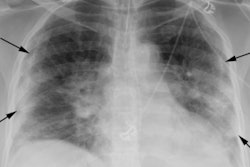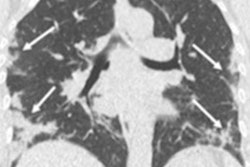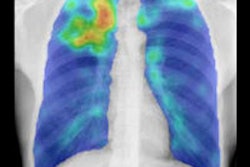.png?auto=format%2Ccompress&q=70&w=400)
Investigators from Brescia, Italy, have revealed details of their chest x-ray scoring system for evaluating and tracking COVID-19 findings. They unveiled their results on 1 May in La Radiologia Medica.
Their results could make x-ray an even more useful tool in the stressful environment of COVID-19 care, wrote Dr. Andrea Borghesi and Dr. Roberto Maroldi, both of the University of Brescia.
"Although chest x-ray is considered not sensitive for the detection of pulmonary involvement in the early stage of the disease, we believe that, in the current emergency setting, [it] can be a useful diagnostic tool for monitoring the rapid progression of lung abnormalities in infected patients, particularly in intensive care units," the team wrote.
The current gold standard for diagnosing SARS-CoV-2 is the reverse transcription polymerase chain reaction (RT-PCR) assay; chest CT is used to detect lung abnormalities in early-stage COVID-19 and to assess the disease's severity, the authors noted.
However, as more and more patients are hospitalized, pressure on CT workflow is increasing. Although chest x-ray isn't as sensitive as CT for detecting lung involvement in early COVID-19, it can be a useful monitoring tool.
But there must be a sound scoring framework. The current chest x-ray scoring system is a five-point tool designed for nonradiologists to assess hospitalized patients with acute respiratory infection. As an alternative, Borghesi and Maroldi developed a scoring system to help radiologists quantify and monitor COVID-19 pneumonia in hospitalized patients.
In the current study, they assessed the system's performance with a sample of 100 patients whose final outcome (that is, recovery or death) was available.
The scoring system included two steps. First, the lungs were divided into six zones on frontal chest projection (two upper zones, two middle, and two lower). Second, each zone was scored based on the following:
- 0: No lung abnormalities
- 1: Interstitial infiltrates
- 2: Interstitial and alveolar infiltrates (interstitial predominance)
- 3: Interstitial and alveolar infiltrates (alveolar predominance)
The researchers added the scores of the six lung zones for an overall score between 0 and 18. A thoracic radiologist independently assessed each of the 100 reports, evaluating the original score. Borghesi and Maroldi then compared the agreement between the initial scoring and the assessment scoring using kappa values.
The median chest x-ray score for the original exams using the system was 6.5, while the median score assigned by the second reader was 7. Kappa agreement between the two scores was 0.82. The team also found that both the initial and second-reader scores were higher for patients who died than for those who were discharged (p ≤ 0.002).
The scoring system proved useful, but more testing is needed, the authors wrote.
"We realize that this method requires further studies to confirm its validity, because the score depends mainly on the quality of the chest x-ray images and the experience of the observers," they concluded," the wrote. "However, in the preliminary validation study, we found that the interobserver agreement was very good and the [chest x-ray] score was a useful parameter for predicting mortality in hospitalized patients with SARS-CoV-2 infection."



















